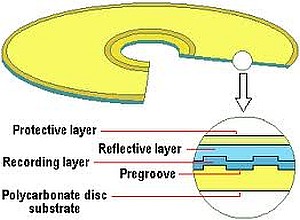If you have read the HowStuffWorks article How CDs Work, you know that the basic idea behind data storage on a normal CD is simple. The surface of the CD contains one long spiral track of data. Along the track, there are flat reflective areas and non-reflective bumps. A flat reflective area represents a binary 1, while a non-reflective bump represents a binary 0. The CD drive shines a laser at the surface of the CD and can detect the reflective areas and the bumps by the amount of laser light they reflect. The drive converts the reflections into 1s and 0s to read digital data from the disc. See How CDs Work for more information.
Normal CDs can not be modified — they are read-only devices. A CD-R disc needs to allow the drive to write data onto the disc. For a CD-R disk to work, there must be a way for a laser to create a non-reflective area on the disc. A CD-R disc therefore has an extra layer that the laser can modify. This extra layer is a greenish dye. In a normal CD, you have a plastic substrate covered with a reflective aluminum or gold layer. In a CD-R, you have a plastic substrate, a dye layer and a reflective gold layer. On a new CD-R disc, the entire surface of the disc is reflective — the laser can shine through the dye and reflect off the gold layer.
When you write data to a CD-R, the writing laser (which is much more powerful than the reading laser) heats up the dye layer and changes its transparency. The change in the dye creates the equivalent of a non-reflective bump. This is a permanent change, and both CD and CD-R drives can read the modified dye as a bump later on.
It turns out that the dye is fairly sensitive to light — it has to be in order for a laser to modify it quickly. Therefore, you want to avoid exposing CD-R discs to sunlight.
For more Detail: How do CD-R discs work?

